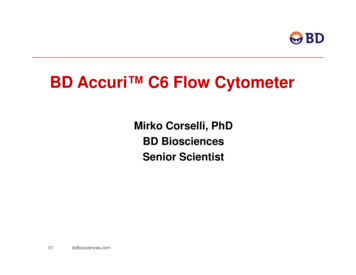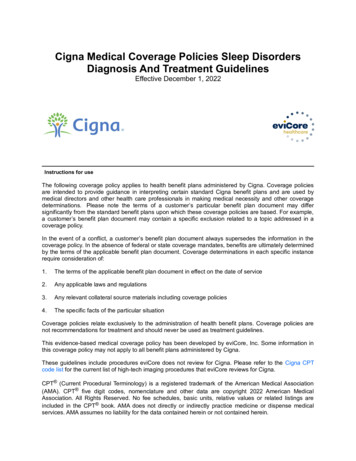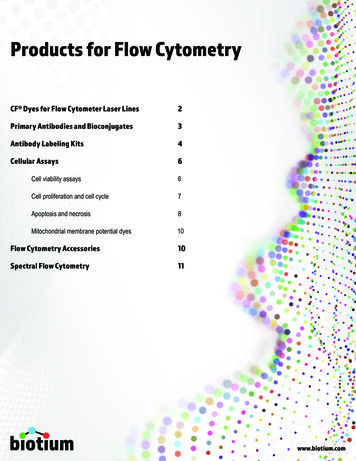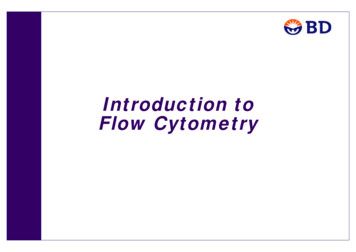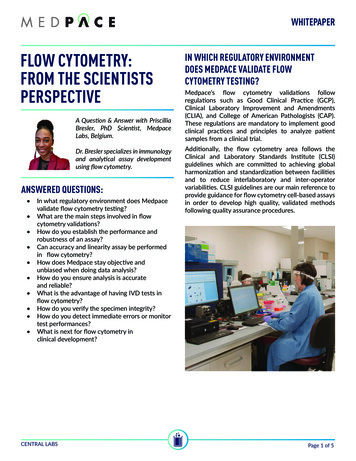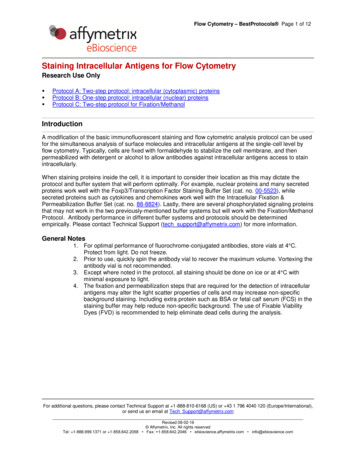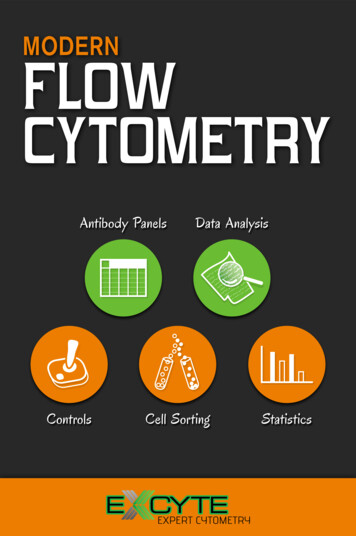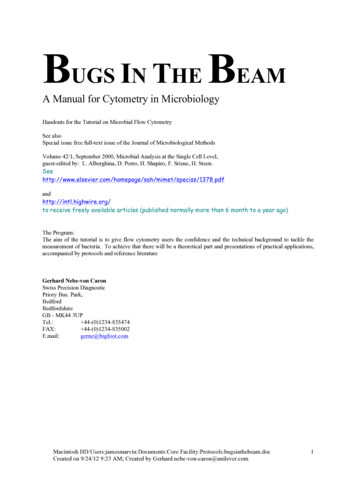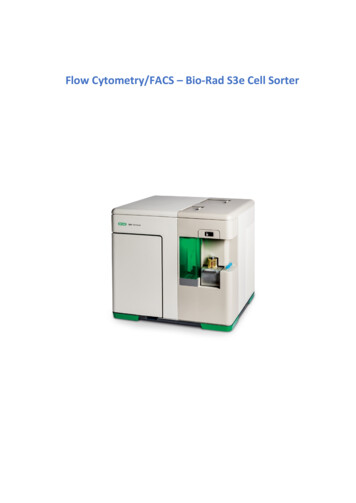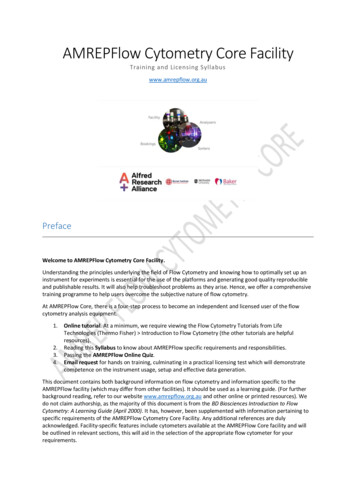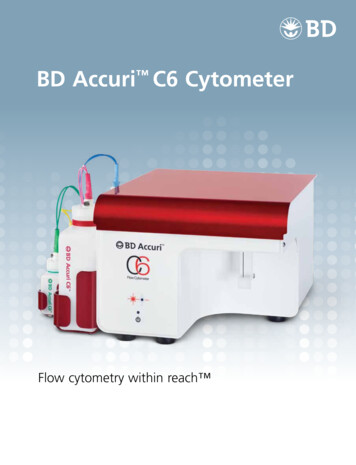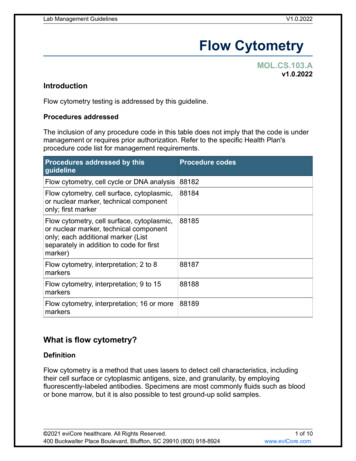
Transcription
Lab Management GuidelinesV1.0.2022Flow CytometryMOL.CS.103.Av1.0.2022IntroductionFlow cytometry testing is addressed by this guideline.Procedures addressedThe inclusion of any procedure code in this table does not imply that the code is undermanagement or requires prior authorization. Refer to the specific Health Plan'sprocedure code list for management requirements.Procedures addressed by thisguidelineProcedure codesFlow cytometry, cell cycle or DNA analysis 88182Flow cytometry, cell surface, cytoplasmic, 88184or nuclear marker, technical componentonly; first markerFlow cytometry, cell surface, cytoplasmic, 88185or nuclear marker, technical componentonly; each additional marker (Listseparately in addition to code for firstmarker)Flow cytometry, interpretation; 2 to 8markers88187Flow cytometry, interpretation; 9 to 15markers88188Flow cytometry, interpretation; 16 or more 88189markersWhat is flow cytometry?DefinitionFlow cytometry is a method that uses lasers to detect cell characteristics, includingtheir cell surface or cytoplasmic antigens, size, and granularity, by employingfluorescently-labeled antibodies. Specimens are most commonly fluids such as bloodor bone marrow, but it is also possible to test ground-up solid samples. 2021 eviCore healthcare. All Rights Reserved.400 Buckwalter Place Boulevard, Bluffton, SC 29910 (800) 918-89241 of 10www.eviCore.com
Lab Management GuidelinesV1.0.2022Flow cytometry procedure codingThe following combination(s) of CPT codes may be used unless more specific CPTcodes exist (e.g., 86355-86367, 86828-86835). Any deviation from these CPT codingstandards is subject to review and denial if not properly coded. 88184 is used to describe the technical component of the first marker applied(maximum one unit) 88185 is used for each additional marker applied and billed with the applicablenumber of units. Therefore, 88185 should not be billed without 88184. Because these two codes describe only the technical component, there are threeother interpretation codes that may be applied based on the number of markersassessed (each billed with a maximum of one unit):o 88187 for evaluating 2 to 8 markerso 88188 for evaluating 9 to 15 markerso 88189 for evaluating 16 or more markersCommon usesA variety of disorders are associated with distinct biomarker patterns, which can beused to diagnose, subtype, or monitor these disorders. 1 The following are commonuses of flow cytometry in medicine:Hematopoietic neoplasm evaluation and monitoring is the most common use of flowcytometry, which includes leukemia and lymphoma phenotyping and minimalresidual disease (MRD) detection. MRD is when individuals with acute leukemiaappear to be in remission having levels of disease below morphologic detection onbone marrow samples but detectable through flow cytometry. Initial panels aregenerally smaller and made to account for all major cell populations while moreextensive flow cytometry evaluation should be reserved for those cases with ahigher likelihood of a new diagnosis of leukemia/lymphoma based on initialpanel/evaluation.2,3 In MRD, a limited panel based upon the patient’s originaldisease immunophenotype may be employed.HIV infection monitoringFlow cytometry is used for HIV infection monitoring to accurately and reliablyevaluate the number of CD4 positive T lymphocytes. 4ImmunodeficiencyFlow cytometry is used for immunodeficiencies, which may be associated withabsent or impaired cell proteins (primary disease), leukocyte dysfunction, andmarkers of immune status in lymphocytes (secondary disease). 1 2021 eviCore healthcare. All Rights Reserved.400 Buckwalter Place Boulevard, Bluffton, SC 29910 (800) 918-89242 of 10www.eviCore.comFlow CytometryHematopoietic neoplasm evaluation and monitoring
Lab Management GuidelinesV1.0.2022Paroxysmal nocturnal hemoglobinuriaParoxysmal nocturnal hemoglobinuria (PNH), a rare stem cell disorder, isdiagnosed through the detection of deficient antigens on red blood cells,monocytes, and/or granulocytes by flow cytometry.1CriteriaIntroductionRequests for flow cytometry testing are reviewed using these criteria. This guidelineaddresses common clinical applications of flow cytometry-based tests that are billedusing CPT codes 88184-88189. It is not intended to encompass flow cytometry-basedtests billed using more specific CPT codes (e.g., 86355-86367, 86828-86835).Hematopoietic Neoplasm Evaluation and MonitoringMedical necessity requirements:Because the flow cytometry markers used to evaluate a sample are necessarilydifferent based on clinical indication, information from other evaluations (e.g.,morphology), sample type, and the laboratory setting, this guideline addresses generalprinciples of marker panel selection.2 Of note, many labs are now using 8 color flowcytometry panels; increased color panels provide more accuracy in identifying differentcell populations, better sensitivity in detecting low levels of minimal residual disease(the finding of which can affect patient outcomes), and the ability to better analyze evenvery small or paucicellular specimens.3,5 In the initial evaluation of suspected hematopoietic neoplasm:o A limited but sufficient number of markers should be used in the initial evaluationthat allows identification of all major categories of neoplasia (B, T, myeloid, orplasma cell lineages) under consideration based on the clinical indication.o Testing with additional markers is indicated to further characterize disease whenthe initial evaluation is suggestive of a hematopoietic neoplasm. For staging or evaluating residual disease in patients with a known diagnosis ofhematopoietic neoplasm, a limited panel of markers characteristic of that neoplasmshould be used.Billing and reimbursement considerations:Most presentations, even non-specific indications that require evaluation of severallineages (e.g., anemia, thrombocytopenia, etc.), should rarely require more than 23flow cytometry markers.2 In those cases in which a new leukemia diagnosis needs 2021 eviCore healthcare. All Rights Reserved.400 Buckwalter Place Boulevard, Bluffton, SC 29910 (800) 918-89243 of 10www.eviCore.comFlow Cytometryo Common non-neoplastic causes of the clinical presentation (e.g., infection orasplenia with leukocytosis, etc.) should be reasonably ruled out before flowcytometry is employed.
Lab Management GuidelinesV1.0.2022confirmation and further characterization, up to 27 flow cytometry markers are usuallyemployed.6 Monitoring of a known hematopoietic neoplasm requires fewer flowcytometry markers, usually less than 18.7 Therefore: In addition to the one marker represented by CPT 88184, reimbursement willroutinely be limited to 22 units of CPT 88185 for non-new leukemic cases, 26 unitsof CPT 88185 for new leukemia diagnoses, and 17 units of CPT 88185 for diseasemonitoring. ICD code information may be compared with units billed to identify cases withpossible excess units that will require post-service medical necessity review.Expected unit number is based on the required cell lineage evaluation by medicalindication outlined in reported flow cytometry guidelines. 2,6,7 When a laboratory routinely bills more than an average of 20 markers, claims fromthat laboratory will be subject to post-service medical necessity review.HIV MonitoringMedical necessity requirements: Flow cytometry is an important method for determining the percentage oflymphocytes that express antigens used to identify CD4 T cells, and to directlymeasure absolute T cell counts in the case of single-platform technology (SPT). 4 Four antibodies are routinely required (CD45, CD3, CD4, CD8), which may beapplied in three- or four-color antibody panels. For pediatric patients, additional antibodies may be required to determine CD19 Bcell values, which is an indicator of immune status in this population. The most commonly required flow cytometry studies for HIV are represented bymarker-specific CPT codes (e.g., 86355-86367). The non-specific flow cytometrycodes should not be used when a more specific code exists. Therefore, the non-specific CPT codes addressed in this policy should not routinelybe required for HIV monitoring. Post-service medical necessity review may beemployed when such codes are used for HIV monitoring as indicated by thefollowing ICD codes: ICD10 Codes:oICD10 Codes Indicating HIV Positive StatusNon-Reimbursed Clinical IndicationsMedical necessity requirements:Flow cytometry procedures will not be reimbursed for the evaluation of the followingindications: 2021 eviCore healthcare. All Rights Reserved.400 Buckwalter Place Boulevard, Bluffton, SC 29910 (800) 918-89244 of 10www.eviCore.comFlow CytometryBilling and reimbursement considerations:
Lab Management GuidelinesV1.0.2022 Detection of sexually transmitted organisms, such as human papillomavirus Hypertension or cardiovascular disease riskBilling and reimbursement considerations:Flow cytometry will not be reimbursed when billed with any of the following ICD codes: ICD10 Codes:oICD10 Codes Indicating Testing for STIsoICD10 Codes Indicating Testing for Hypertension or Cardiovascular Disease ScreeningOther Clinical IndicationsMedical Necessity Requirements:Flow cytometry has a variety of applications that cannot all be adequately addressedby this guideline. All flow cytometry studies must be performed for well-validated andmedically necessary indications.Billing and reimbursement considerations:When flow cytometry is billed with ICD codes that do not suggest one of the otherclinical indications addressed in this policy, post-service medical necessity review maybe employed. See the Reimbursement Policy that addresses Post-Service MedicalNecessity Determination for more information.ICD10 CodesICD10 codes in this section may be used to support or refute medical necessity asdescribed in the above criteria.ICD10 Code or RangeDescriptionB20Human immunodeficiency virus [HIV]disease resulting in infectious andparasite diseasesB21Human immunodeficiency virus [HIV]disease resulting in malignant neoplasmsB22Human immunodeficiency virus [HIV]resulting in other specified diseasesB23Human immunodeficiency virus [HIV]disease resulting in other conditionsB97.35Human immunodeficiency virus, type 2[HIV-2] 2021 eviCore healthcare. All Rights Reserved.400 Buckwalter Place Boulevard, Bluffton, SC 29910 (800) 918-89245 of 10www.eviCore.comFlow CytometryICD10 Codes Indicating HIV Positive Status
Lab Management GuidelinesV1.0.2022ICD10 Code or RangeDescriptionO98.7XHuman immunodeficiency virus [HIV]disease complicating pregnancy, childbirthand the puerperiumR75Inconclusive laboratory evidence ofhuman immunodeficiency virus [HIV]Z21Asymptomatic human immunodeficiencyvirus [HIV] infection statusICD10 Code or RangeDescriptionA50.XCongenital syphilisA51.XEarly syphilisA52.XLate syphilisA53.XOther and unspecified syphilisA54.XGonococcal infectionA55Chlamydial lymphogranuloma (venereum)A56.XOther sexually transmitted chlamydialdiseasesA57ChancroidA58Granuloma inguinaleA59.XTrichomoniasisA60.XAnogenital herpesviral [herpes simplex]infectionsA63.XOther predominantly sexually transmitteddiseases, not elsewhere classifiedA64Unspecified sexually transmitted diseaseA74.89Other chlamydial diseasesA74.9Chlamydial infection, unspecified(includes childbirth and postpartum)B37.3Candidiasis of vulva and vaginaB37.4XCandidiasis of other urogenital sitesB97.7Papillomavirus as the cause of diseasesclassified elsewhereL29.3Anogenital pruritus, unspecified 2021 eviCore healthcare. All Rights Reserved.400 Buckwalter Place Boulevard, Bluffton, SC 29910 (800) 918-89246 of 10www.eviCore.comFlow CytometryICD10 Codes Indicating Testing for STIs
V1.0.2022ICD10 Code or RangeDescriptionM02.30Reiter's disease, unspecified siteN34.XUrethritis and urethral syndromeN35.111Postinfective urethral stricture, notelsewhere classified, male, meatalN37Urethral disorders in diseases classifiedelsewhereN39.0Urinary tract infection, site not specifiedN39.9Disorder of urinary system, unspecifiedN70.XSalpingitis and oophoritisN71.XInflammatory disease of uterus, exceptcervixN72Inflammatory disease of cervix uteriN73.XOther female pelvic inflammatorydiseasesN74Female pelvic inflammatory disorders indiseases classified elsewhereN75.XDiseases of Bartholin's glandN76.XOther inflammation of vagina and vulvaN77.XVulvovaginal ulceration and inflammationin diseases classified elsewhereN94.1DyspareuniaO09.XSupervision of high risk pregnancyO23.XInfections of genitourinary tract inpregnancyO86.1XOther infection of genital tract followingdeliveryO86.2XUrinary tract infection following deliveryR87.5Abnormal microbiological findings inspecimens from female genital organsR87.6XAbnormal cytological findings inspecimens from female genital organsR87.8XOther abnormal findings in specimensfrom female genital organsZ00.00Encounter for general adult medicalexamination without abnormal findings 2021 eviCore healthcare. All Rights Reserved.400 Buckwalter Place Boulevard, Bluffton, SC 29910 (800) 918-89247 of 10www.eviCore.comFlow CytometryLab Management Guidelines
V1.0.2022ICD10 Code or RangeDescriptionZ00.8Encounter for other general examinationZ01.4XEncounter for gynecological examinationZ11.3Encounter for screening for infections witha predominantly sexual mode oftransmissionZ11.51Encounter for screening for humanpapillomavirus (HPV)Z11.59Encounter for screening for other viraldiseasesZ11.8Encounter for screening for otherinfectious and parasitic diseasesZ11.9Encounter for screening for infectious andparasitic diseases, unspecifiedZ12.4Encounter for screening for malignantneoplasm of cervixZ20.2Contact with and (suspected) exposure toinfections with a predominantly sexualmode of transmissionZ20.6Contact with and (suspected) exposure tohuman immunodeficiency virus [HIV]Z20.818Contact with and (suspected) exposure toother bacterial communicable diseasesZ20.828Contact with and (suspected) exposure toother viral communicable diseasesZ20.89Contact with and (suspected) exposure toother communicable diseasesZ20.9Contact with and (suspected) exposure tounspecified communicable diseaseZ30.XEncounter for contraceptive managementZ31.XEncounter for procreative managementZ32.XEncounter for pregnancy test andchildbirth and childcare instructionZ33.XPregnant stateZ34.XEncounter for supervision of normalpregnancyZ36Encounter for antenatal screening ofmother 2021 eviCore healthcare. All Rights Reserved.400 Buckwalter Place Boulevard, Bluffton, SC 29910 (800) 918-89248 of 10www.eviCore.comFlow CytometryLab Management Guidelines
Lab Management GuidelinesV1.0.2022ICD10 Code or RangeDescriptionZ39.XEncounter for maternal postpartum careand examinationZ64.0Problems related to unwanted pregnancyZ64.1Problems related to multiparityZ71.7Human immunodeficiency virus [HIV]counselingZ72.5XHigh risk sexual behaviorZ77.9Other contact with and (suspected)exposures hazardous to healthZ97.5Presence of (intrauterine) contraceptivedeviceICD10 Code or RangeDescriptionI10Essential (primary) hypertensionI11.XHypertensive heart diseaseI12.XHypertensive chronic kidney diseaseI13.XHypertensive heart and chronic kidneydiseaseI15.XSecondary hypertensionI20.XAngina pectorisI21.XST elevation (STEMI) and non-STelevation (NSTEMI) myocardial infarctionI22.XSubsequent ST elevation (STEMI) andnon-ST elevation (NSTEMI) myocardialinfarctionI23.XCertain current complications following STelevation (STEMI) and non-ST elevation(NSTEMI) myocardial infarction (within the28 day period)I24.XOther acute ischemic heart diseasesI25.XChronic ischemic heart diseaseR07.2Precordial painR07.8XOther chest painR07.9Chest pain, unspecified 2021 eviCore healthcare. All Rights Reserved.400 Buckwalter Place Boulevard, Bluffton, SC 29910 (800) 918-89249 of 10www.eviCore.comFlow CytometryICD10 Codes Indicating Testing for Hypertension or Cardiovascular Disease Screening
Lab Management GuidelinesV1.0.2022ICD10 Code or RangeDescriptionR09.89Other specified symptoms and signsinvolving the circulatory and respiratorysystemsR94.3XAbnormal results of cardiovascularfunction studiesZ13.6Encounter for screening for cardiovasculardisordersZ82.4XFamily history of ischemic heart diseaseand other diseases of the circulatorysystemReferencesIntroductionThese references are cited in this guideline.1. Ormerod M. Flow Cytometry A Basic Introduction. Available at:http://flowbook.denovosoftware.com/. Last updated 2008.2. Wood BL, Arroz M, Barnett D, et al. 2006 Bethesda International Consensusrecommendations on the immunophenotypic analysis of hematolymphoidneoplasiaby flow cytometry: optimal reagents and reporting for the flow cytometric diagnosisof hematopoietic neoplasia. Cytometry B Clin Cytom. 2007; 72(suppl 1):S14-S22.4. Mandy FF, Nicholson JK, McDougal JS; CDC. Guidelines for performing singleplatform absolute CD4 T-cell determinations with CD45 gating for personsinfected with human immunodeficiency virus. Centers for Disease Control andPrevention. MMWR Recomm Rep. 2003 Jan 31; 52(RR-2):1-13. Available at: htm5. Chen X, Wood BL. Monitoring minimal residual disease in acute leukemia:Technical challenges and interpretive complexities. Blood Rev. 2017 Mar;31(2):6375.6. Béné MC, Nebe T, Bettelheim P, et al. Immunophenotyping of acute leukemia andlymphoproliferative disorders: a consensus proposal of the European LeukemiaNetWork Package 10. Leukemia. 2011 Apr;25(4):567-74.7. Fuda F, Chen W. Minimal/measurable residual disease detection in acuteleukemias by multiparameter flow cytometry. Curr Hematol Malig Rep. 2018Dec;13(6):455-466. 2021 eviCore healthcare. All Rights Reserved.400 Buckwalter Place Boulevard, Bluffton, SC 29910 (800) 918-892410 of 10www.eviCore.comFlow Cytometry3. Wood B. 9-color and 10-color flow cytometry in the clinical laboratory. Arch PatholLab Med. 2006 May;130(5):680-90.
monocytes, and/or granulocytes by flow cytometry.1 Criteria Introduction Requests for flow cytometry testing are reviewed using these criteria. This guideline addresses common clinical applications of flow cytometry-based tests that are billed using CPT codes 88184-88189. It is not intended to encompass flow cytometry-based
